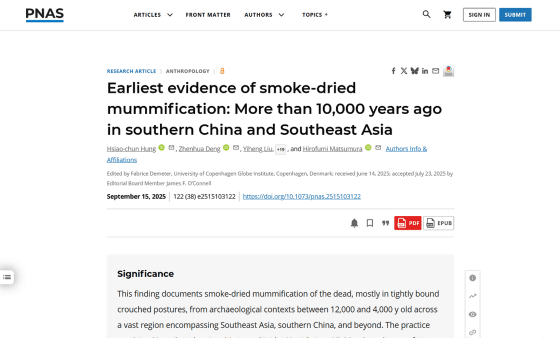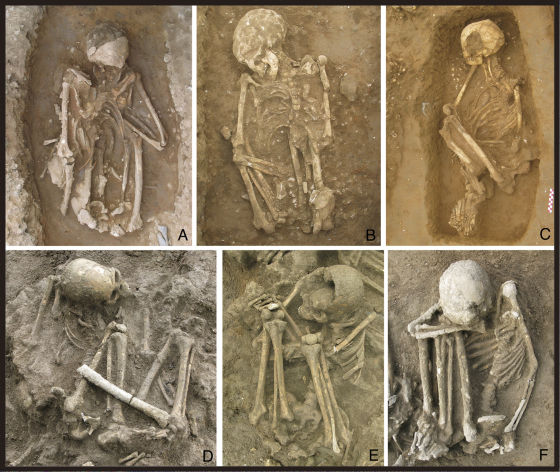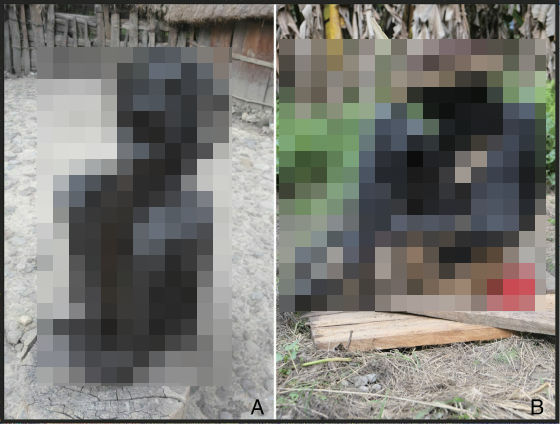The world's oldest mummies were not made in Egypt but in Southeast Asia and China more than 10,000 years ago, by 'smoking' the dead.

When we think of
Earliest evidence of smoke-dried mummification: More than 10,000 years ago in southern China and Southeast Asia | PNAS
https://www.pnas.org/doi/full/10.1073/pnas.2515103122

Oldest Human Mummies Discovered, And They're Not What We Expected : ScienceAlert
https://www.sciencealert.com/oldest-human-mummies-discovered-and-theyre-not-what-we-expected
People in Southeast Asia and China were mummifying their dead thousands of years before the Egyptians did, smoke-dried human remains reveal | Live Science
https://www.livescience.com/archaeology/worlds-oldest-mummies-were-smoke-dried-10-000-years-ago-in-china-and-southeast-asia-researchers-find
Archaeologists have long known that Neolithic burials across a wide range of regions, including Southeast Asia and southern China, often feature common features such as the bodies of the deceased in a crouched or fetal position, being tightly bound, and having some of their bones burned. However, it was unclear how these cultures prepared their dead and achieved their unique burial positions.
The photos below show remains from the early to middle Holocene found in southern China. All of them appear to be in a crouching position, hugging their knees.

A research team led by Australian National University archaeologist Hsiao-chun Hung hypothesized that the method of 'smoking and drying the dead,' which is still practiced by some ethnic groups living in the highlands of
The research team analyzed 69 bone samples from 11 different archaeological sites in southern China, northern Vietnam, and Indonesia, dating back 4,000 to 12,000 years ago. The analysis used X-ray diffraction , which can detect structural changes in bones that occur at temperatures above 500 degrees Celsius, and Fourier transform infrared spectroscopy, which can detect changes in bones at lower temperatures.
Of the 64 bone samples with reliable results, 84% showed signs of heat exposure, including intentional cutting marks on some bones. Some bones also showed soot deposits and discoloration due to low-intensity heating, suggesting that the remains had been smoked.
The researchers speculate that the burial practices of these cultures, including smoking and drying the bodies, were similar to those still practiced today by the Dani people of New Guinea, who tie up the bodies in a crouching position and hang them over a low, smoky flame for weeks or months.
The photo below shows smoked bodies kept in Dani homes. Click on the image to remove the mosaic.

The remains of the research team consist of only bones, with no skin, soft tissue, or hair preserved, making them different from mummies found in Egypt and elsewhere. However, because they were intentionally mummified by drying in a smoking oven, the research team considers them to be mummies.
'The main difference with mummies as we typically imagine them is that these ancient smoked bodies were not sealed in containers after the smoking process, so their preservation period was generally only a few decades to a few hundred years,' Hung said.
'In the hot and humid climates of southern China and Southeast Asia, smoking was likely the most effective way to preserve bodies for long periods of time. However, how ancient hunter-gatherers discovered the art of smoking remains an intriguing mystery. Hung believes that ancient peoples may have discovered smoking by chance or as a by-product of some ritual, or that they may have adapted it from the practice of smoking animal meat.'
'The tradition of smoking mummification provides strong evidence of long-term cultural continuity between ancient Southeast Asia and ethnographic Papua-Australia burial practices,' the researchers wrote. 'Furthermore, archaeological findings suggest that this tradition may have been known for thousands of years across a vast region, from Northeast Asia and Jomon Japan to Western Oceania and Australia, and perhaps among hunter-gatherer societies more broadly.'
'What is clear is that this practice prolongs the presence of the deceased in a visible way, allowing ancestors to remain tangible in the world,' Hung said. 'This is a strong reflection of human love, remembrance and devotion.'
Related Posts:
in Free Member, Science, Posted by log1h_ik







